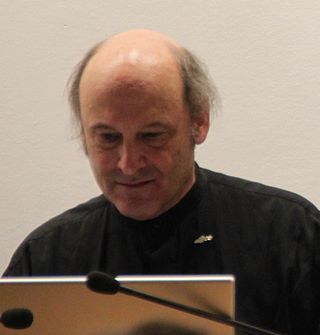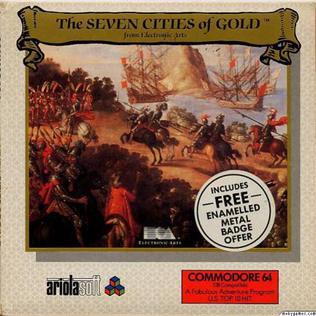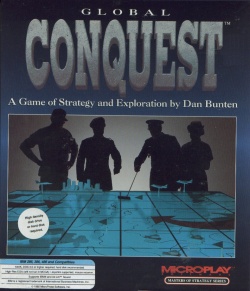In software engineering, porting is the process of adapting software for the purpose of achieving some form of execution in a computing environment that is different from the one that a given program was originally designed for. The term is also used when software/hardware is changed to make them usable in different environments.

M.U.L.E. is a multiplayer video game written for Atari 8-bit computers by Ozark Softscape. Designer Danielle Bunten Berry takes advantage of the four joystick ports of the Atari 400 and 800 to allow four-player simultaneous play. Published in 1983, M.U.L.E. was one of the first five games from new company Electronic Arts, alongside Axis Assassin, Archon: The Light and the Dark, Worms?, and Hard Hat Mack. It is primarily a turn-based strategy game, but incorporates real-time elements where players compete directly as well as aspects that simulate economics.

Danielle Bunten Berry, was an American game designer and programmer, known for the 1983 game M.U.L.E., one of the first influential multiplayer video games, and 1984's The Seven Cities of Gold.

Balance of Power is a strategy video game of geopolitics during the Cold War, created by Chris Crawford and published in 1985 on the Macintosh by Mindscape, followed by ports to a variety of platforms over the next two years.

Christopher Crawford is an American video game designer and writer. Hired by Alan Kay to work at Atari, Inc., he wrote the computer wargame Eastern Front (1941) for Atari 8-bit computers which was sold through the Atari Program Exchange and later Atari's official product line. After leaving Atari, he wrote a string of games beginning with Balance of Power for Macintosh. Writing about the process of developing games, he became known among other creators in the nascent home computer game industry for his passionate advocacy of game design as an art form. He self-published The Journal of Computer Game Design and founded the Computer Game Developers Conference.

Trust & Betrayal: The Legacy of Siboot, often abbreviated simply to Siboot, was a game designed and programmed by Chris Crawford for the Macintosh and published by Mindscape in 1987.
Racter is an artificial intelligence program that generates English language prose at random. It was published by Mindscape for IBM PC compatibles in 1984, then later for the Apple II, Macintosh, and Amiga. An expanded version of the software, not the one released through Mindscape, was used to generate the text for the published book The Policeman's Beard Is Half Constructed.

The Settlers is a 1993 city-building video game with real-time strategy elements for Amiga and MS-DOS. Developed and published by Blue Byte Software, the Amiga version was released in Germany in June 1993 and in the United Kingdom in November. The MS-DOS version was ported by Blue Byte and Massive Development. Blue Byte published this version in Europe under its original title in May 1994, but in North America, it was published in December by SSI as Serf City: Life is Feudal. In 2018, the game was re-released for Windows as The Settlers: History Edition. It is the first game in The Settlers series.

The Seven Cities of Gold is a strategy video game created by Danielle Bunten Berry and Ozark Softscape and published by Electronic Arts in 1984. The player takes the role of a late 15th-century explorer for the Spanish Empire, setting sail to the New World in order to explore the map and interact with the natives in order to win gold and please the Spanish court. The name derives from the "seven cities" of Quivira and Cíbola that were said to be located somewhere in the Southwest United States. It is considered to be one of the earliest open world video games.
Game balance is a branch of game design with the intention of improving gameplay and user experience by balancing difficulty and fairness. Game balance consists of adjusting rewards, challenges, and/or elements of a game to create the intended player experience.

A game client is a network client that connects an individual user to the main game server, used mainly in multiplayer video games. It collects data such as score, player status, position and movement from a single player and send it to the game server, which allows the server to collect each individual's data and show every player in game, whether it is an arena game on a smaller scale or a massive game with thousands of players on the same map. Even though the game server displays each player's information for every player in a game, players still have their own unique perspective from the information collected by the game client, so that every player's perspective of the game is different, even though the world for every player is the same. The game client also allows the information sharing among users. An example would be item exchange in many MMORPG games where a player exchange an item he/she doesn't want for an item he/she wants, the game clients interconnect with each other and allows the sharing of information, in this exchanging items. Since many games requires a centralized space for players to gather and a way for users to exchange their information, many game clients are a hybrid of client-server and peer-to-peer application structures.
A government simulation or political simulation is a game that attempts to simulate the government and politics of all or part of a nation. These games may include geopolitical situations, the creation of domestic political policies, or the simulation of political campaigns. They differ from the genre of classical wargames due to their discouragement or abstraction of military or action elements.

Chris Crawford on Game Design (ISBN 0-13-146099-4) is a book about computer and video game design by Chris Crawford. Although initially intended to be the second edition of The Art of Computer Game Design, the publisher decided, because it was a considerable expansion on the previous book, it should be considered a wholly new work. It was published by Peachpit under the New Riders imprint in 2003. It includes Crawford's response to recent game developments, such as The Sims, and dedicates a chapter to each of his first 14 published games: Tanktics, Legionnaire, Wizard, Energy Czar, Scram, Eastern Front (1941), Gossip, Excalibur, Balance of Power, Patton Versus Rommel, Siboot, The Global Dilemma: Guns & Butter, Balance of the Planet and Patton Strikes Back.

Patton vs. Rommel is a computer wargame designed and programmed by Chris Crawford for the Macintosh and published by Electronic Arts in 1986. Versions for MS-DOS compatible operating systems and Commodore 64 were developed by Sculptured Software and published in 1987.

Legionnaire is a computer wargame for Atari 8-bit computers created by Chris Crawford released through Avalon Hill in 1982. Recreating Julius Caesar's campaigns in a semi-historical setting, the player takes command of the Roman legions in real-time battles against the barbarians.
Algorithmic game theory (AGT) is an area in the intersection of game theory and computer science, with the objective of understanding and design of algorithms in strategic environments.
Dynamic game difficulty balancing (DGDB), also known as dynamic difficulty adjustment (DDA), adaptive difficulty or dynamic game balancing (DGB), is the process of automatically changing parameters, scenarios, and behaviors in a video game in real-time, based on the player's ability, in order to avoid making the player bored or frustrated. The goal of dynamic difficulty balancing is to keep the user interested from the beginning to the end, providing a good level of challenge.

Global Conquest is a video game published by Microplay Software in 1992 for IBM PC compatibles. It is a version of Empire with numerous gameplay upgrades and a multi-player mode supported via modems.

Material balances are a method of economic planning where material supplies are accounted for in natural units and used to balance the supply of available inputs with targeted outputs. Material balancing involves taking a survey of the available inputs and raw materials in an economy and then using a balance sheet to balance the inputs with output targets specified by industry to achieve a balance between supply and demand. This balance is used to formulate a plan for resource allocation and investment in a national economy.

Balance of the Planet is a simulation video game developed by Chris Crawford. He self-published it in 1990 for Macintosh. It was ported to MS-DOS and PC-98.














